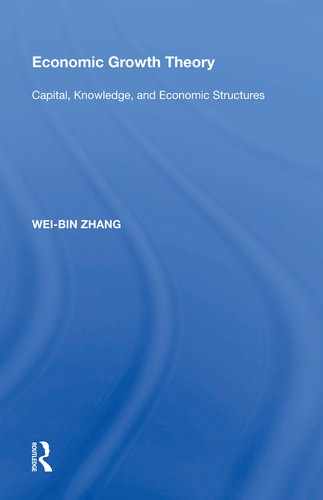0%
22Chapters
0-1Hours read
0kTotal Words
Table of Contents
- Cover
- Half Title
- Title
- Copyright
- Contents
- List of Figures
- List of Tables
- Preface
- Acknowledgements
- 1 Economic Growth and Growth Theory
- 2 The One-Sector Growth (OSG) Model
- 2.1 Behavior of Producers
- 2.2 Behavior of Consumers
- 2.3 On the Generalized Keynesian Consumption Function
- 2.4 Dynamics in Capital-Labor Ratio
- 2.5 Existence of a Stable Steady State
- 2.6 Productivity Improvement, Population Growth and the APS
- 2.7 The Dynamics with the Cobb-Douglas Production Function
- 2.8 The OSG Model with the CES Production Function
- 2.9 The OSG Model with the Leontief Production Function
- 2.10 The OSG Model with General Utility Functions
- 2.11 The OSG Model with Preference Dynamics
- 2.12 The OSG Model in Discrete Time
- 2.13 On the OSG Model
- Appendix
- 3 Traditional Growth Theories and the OSG Model
- 3.1 The Harrod-Domar Model
- 3.2 The Solow Model and the OSG Model
- 3.3 The Life Cycle Hypothesis and the Generalized Keynesian Consumption Function in the OSG Model
- 3.4 The Permanent Income Hypothesis and the Generalized Keynesian Consumption Function
- 3.5 The Ramsey Growth Model
- 3.6 The Ramsey Model and the OSG Model
- 3.7 Poverty Traps Generated in the Solow Model
- 3.8 On the Utility Function in the OSG Model
- Appendix
- 4 Some Extensions of the OSG Model
- 4.1 Exogenous Technological Change
- 4.2 Endogenous Time and the OSG Model
- 4.3 Simulating Evolution of Time Value and Distribution
- 4.4 Public Goods and Returns to Scale
- 4.5 Home Production in the OSG Model
- 4.6 Environment and Growth
- 4.7 Population and Capital Accumulation
- 4.8 Money and Economic Growth
- Appendix
- 5 Income Distribution and Growth
- 5.1 Growth with Income Transfers
- 5.2 Does Inequality Accelerate Growth?
- 5.3 Properties of the Dynamic System
- 5.4 The Distribution Policy and the Equilibrium
- 5.5 Human Capital and the Distribution Policy
- 5.6 Dynamics of the Loren Curve and the Kuznets Curve
- 5.7 Endogenous Time in the Two-Group Model
- 5.8 The OSG Model with Multiple Consumers
- 5.9 Simulating the Three-Group OSG Model
- 5.10 The OSG Model with Sexual Division of Labor
- 5.11 On Modeling Group Differences
- Appendix
- 6 Structural Changes and Development
- 6.1 The Uzawa Two-Sector Model
- 6.2 Refitting the Uzawa Model
- 6.3 Behavior of the Two-Sector Model
- 6.4 A Generalization of the Ricardian Growth Model
- 6.5 Discussion on Growth Rates
- 6.6 Simulating Economic Structural Change
- 6.7 The Propensity to Hold Wealth and Economic Structure
- 6.8 Engel's Law and Structural Change
- 6.9 A Two-Capital Growth Model
- 6.10 Economic Evolution with Multiple Sectors
- Appendix
- 7 Growth, Unemployment and Welfare
- 8 Learning by Doing, Education and Learning by Leisure
- 8.1 The AK-OSG Model with Learning by Doing
- 8.2 The AK-Ramsey Model
- 8.3 The Lucas Growth Model with Education
- 8.4 Growth with Multiple Ways of Learning
- 8.5 Growth Rates and the Education Policy
- 8.6 Lower Propensity to Save and Higher Growth Rates
- 8.7 More Than 'All Work and No Play Make Jack a Dull Boy'
- 8.8 The Dynamic Properties of the Model
- 8.9 Leisure and the Equilibrium Economic Structure
- 8.10 Growth, Human Capital and Unemployment
- 8.11 Human Capital and Economic Development
- Appendix
- 9 Research and Learning by Doing
- 9.1 Growth with Learning by Doing and Research
- 9.2 Growth Rates and the Research Policy
- 9.3 Intermezzo for Multiple Equilibria and Poverty Traps
- 9.4 Equilibrium of the Growth Model with Knowledge
- 9.5 The Policy on Scientists' Payment
- 9.6 The Job Amenities and Economic Structure
- 9.7 Knowledge Accumulation and Economic Structure
- 9.8 Economic Growth with Knowledge and Multiple Groups
- 9.9 On Growth with Endogenous Knowledge
- 10 New Growth Theories and Monopolistic Competition
- 10.1 Development with Monopolistic Competition
- 10.2 Product Variety and Growth
- 10.3 Variety of Consumer Goods and Growth
- 10.4 The Schumpeterian Creative Destruction
- 10.5 Growth with Improvements in Quality of Products
- 10.6 Learning by Doing and Research
- 10.7 The New Growth Theory and Linearized Knowledge Growth
- 11 Complexity of Economic Growth
- Bibliography
- Index
